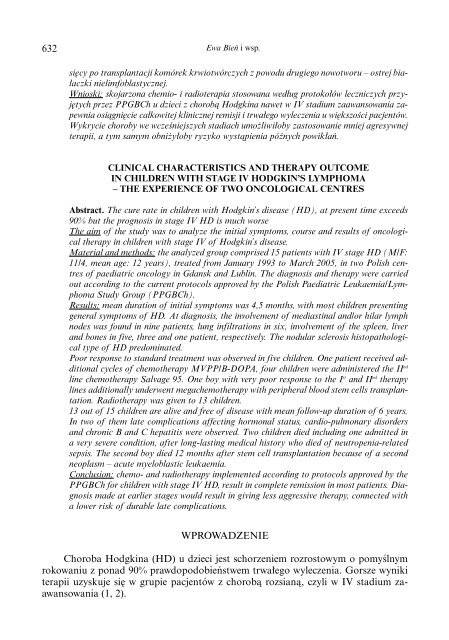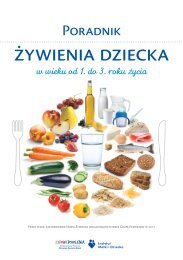Medycyna Wieku Rozwojowego
Medycyna Wieku Rozwojowego
Medycyna Wieku Rozwojowego
You also want an ePaper? Increase the reach of your titles
YUMPU automatically turns print PDFs into web optimized ePapers that Google loves.
632<br />
Ewa Bieƒ i wsp.<br />
si´cy po transplantacji komórek krwiotwórczych z powodu drugiego nowotworu – ostrej bia-<br />
∏aczki nielimfoblastycznej.<br />
Wnioski: skojarzona chemio-i radioterapia stosowana wed∏ug protoko∏ów leczniczych przyj´tych<br />
przez PPGBCh u dzieci z chorobà Hodgkina nawet w IV stadium zaawansowania zapewnia<br />
osiàgni´cie ca∏kowitej klinicznej remisji i trwa∏ego wyleczenia u wi´kszoÊci pacjentów.<br />
Wykrycie choroby we wczeÊniejszych stadiach umo˝liwi∏oby zastosowanie mniej agresywnej<br />
terapii, a tym samym obni˝y∏oby ryzyko wystàpienia póênych powik∏aƒ.<br />
CLINICAL CHARACTERISTICS AND THERAPY OUTCOME<br />
IN CHILDREN WITH STAGE IV HODGKIN’S LYMPHOMA<br />
– THE EXPERIENCE OF TWO ONCOLOGICAL CENTRES<br />
Abstract. The cure rate in children with Hodgkin’s disease (HD), at present time exceeds<br />
90% but the prognosis in stage IV HD is much worse<br />
The aim of the study was to analyze the initial symptoms, course and results of oncological<br />
therapy in children with stage IV of Hodgkin’s disease.<br />
Material and methods: the analyzed group comprised 15 patients with IV stage HD (M/F:<br />
11/4, mean age: 12 years), treated from January 1993 to March 2005, in two Polish centres<br />
of paediatric oncology in Gdansk and Lublin. The diagnosis and therapy were carried<br />
out according to the current protocols approved by the Polish Paediatric Leukaemia/Lymphoma<br />
Study Group (PPGBCh).<br />
Results: mean duration of initial symptoms was 4,5 months, with most children presenting<br />
general symptoms of HD. At diagnosis, the involvement of mediastinal and/or hilar lymph<br />
nodes was found in nine patients, lung infiltrations in six, involvement of the spleen, liver<br />
and bones in five, three and one patient, respectively. The nodular sclerosis histopathological<br />
type of HD predominated.<br />
Poor response to standard treatment was observed in five children. One patient received additional<br />
cycles of chemotherapy MVPP/B-DOPA, four children were administered the II nd<br />
line chemotherapy Salvage 95. One boy with very poor response to the I st and II nd therapy<br />
lines additionally underwent megachemotherapy with peripheral blood stem cells transplantation.<br />
Radiotherapy was given to 13 children.<br />
13 out of 15 children are alive and free of disease with mean follow-up duration of 6 years.<br />
In two of them late complications affecting hormonal status, cardio-pulmonary disorders<br />
and chronic B and C hepatitis were observed. Two children died including one admitted in<br />
a very severe condition, after long-lasting medical history who died of neutropenia-related<br />
sepsis. The second boy died 12 months after stem cell transplantation because of a second<br />
neoplasm – acute myeloblastic leukaemia.<br />
Conclusion: chemo-and radiotherapy implemented according to protocols approved by the<br />
PPGBCh for children with stage IV HD, result in complete remission in most patients. Diagnosis<br />
made at earlier stages would result in giving less aggressive therapy, connected with<br />
a lower risk of durable late complications.<br />
WPROWADZENIE<br />
Choroba Hodgkina (HD) u dzieci jest schorzeniem rozrostowym o pomyÊlnym<br />
rokowaniu z ponad 90% prawdopodobieƒstwem trwa∏ego wyleczenia. Gorsze wyniki<br />
terapii uzyskuje si´ w grupie pacjentów z chorobà rozsianà, czyli w IV stadium zaawansowania<br />
(1, 2).



